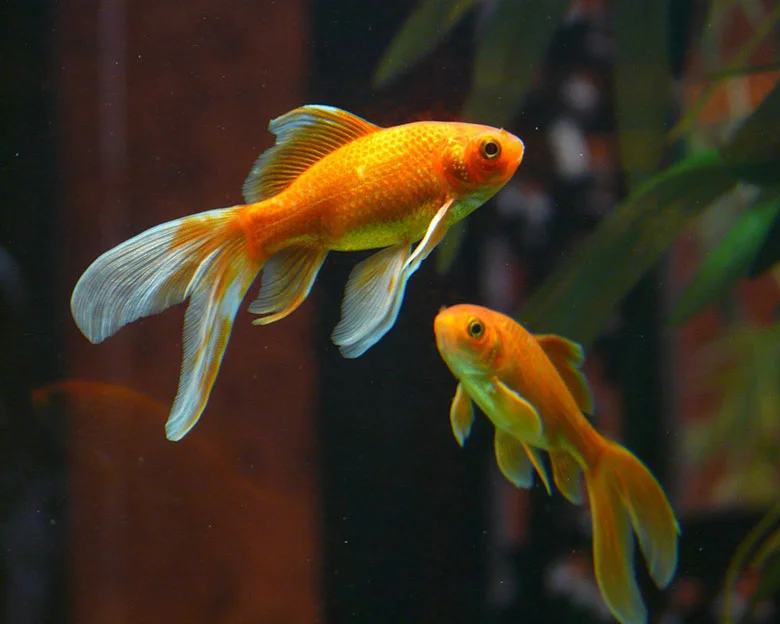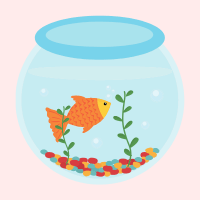Have you ever wondered about the intricate process of goldfish mating? It is truly a fascinating phenomenon that unveils the secrets of reproduction in these captivating aquatic creatures.
In this article, we will delve into the world of goldfish mating, shedding light on the intricacies of their reproductive journey.
Just like in nature, goldfish have their own mating season. When spring arrives and the water temperature reaches a balmy 60-70 degrees Fahrenheit, the magic begins. Male goldfish develop prominent white spots known as breeding tubercles, while females display smaller white spots and a swollen belly. If you see black spots on your Goldfish, this is a separate issue that needs to be looked at. These physical changes signify their readiness for reproduction.
To create the ideal conditions for mating, it is crucial to maintain a tank temperature within the recommended range and provide clean, well-oxygenated water. A good filter system and regular water changes are imperative for their well-being.
During the mating process, the male goldfish chases and nudges the female, encouraging her to release her eggs. These eggs are then fertilized by the male’s sperm. To protect the eggs, they should be carefully removed and placed in a separate tank.
After a few days, the eggs hatch, and the fry remain attached to their egg sacs before swimming freely and feeding on microscopic organisms. It takes several weeks for the fry to fully develop, and providing them with a high-quality diet is essential for their healthy growth.
Understanding the intricacies of goldfish mating is crucial for ensuring proper care and nurturing for these beloved pet fish. So, let’s uncover the fascinating process of goldfish mating and unlock the secrets of their reproductive journey together.
Key Takeaways
- Goldfish start mating at around one year old and should be fully mature before breeding.
- The mating season for goldfish typically begins in the spring when water temperatures rise to 60-70 degrees Fahrenheit.
- Creating a tank setup that mimics the natural environment with goldfish-friendly plants and decorations is important for breeding.
- Goldfish eggs take about 4-7 days to hatch, and the incubation period depends on the water temperature.
How Goldfish Mate

To understand how goldfish mate, you need to know that they start mating at around one year old and should be fully mature before breeding. The mating season for goldfish typically begins in the spring when water temperatures rise to 60-70 degrees Fahrenheit.
Goldfish breeding behavior involves distinct characteristics in males and females. Male goldfish develop white spots called breeding tubercles on their heads and fins, while females develop smaller white spots and a swollen belly. These physical changes indicate readiness for mating.
Goldfish reproduction cycle starts with spawning, where the male chases and nudges the female to release her eggs. Fertilization occurs when the male releases sperm to fertilize the eggs, which are sticky and adhere to plants or objects in the tank. It is important to remove the eggs and place them in a separate tank to protect them from being eaten.
The eggs take about 4-7 days to hatch, and the incubation period depends on the water temperature. After hatching, goldfish fry remain attached to their egg sacs for a few days before swimming and feeding on microscopic organisms.
Understanding goldfish mating behavior and their reproductive cycle can help provide better care for these fascinating creatures.
Mating Season and Conditions
Imagine yourself in a vibrant springtime garden, where the warm sun gently kisses the water, inviting goldfish to awaken from their slumber and embark on a delicate dance of courtship. During the mating season, various factors influence the success of goldfish breeding.
Here are some important aspects to consider:
- Breeding habits of different goldfish species: Different goldfish species have unique breeding habits. For example, fancy goldfish tend to have more difficulty breeding due to their modified body shapes, while single-tailed goldfish are more successful breeders.
- Factors affecting goldfish mating success: Several factors can impact the success of goldfish mating. These include water temperature, water quality, tank size, and the male-to-female ratio. Maintaining the ideal temperature range of 60-70 degrees Fahrenheit and providing clean, well-oxygenated water with regular water changes ensures optimal breeding conditions.
- Additionally, having a 2:1 male-to-female ratio promotes competition and motivation for mating.
Understanding the breeding habits of different goldfish species and considering the factors that affect mating success can greatly enhance your ability to support and facilitate successful goldfish breeding.
The Mating Process
Get ready to witness the enchanting dance of courtship as male goldfish chase and nudge their female counterparts to release their eggs. The mating process of goldfish is a fascinating display of nature’s intricacy. To better understand this process, let’s explore the factors that affect goldfish mating success. One crucial factor is water temperature.
Goldfish typically begin mating when water temperatures rise to 60-70 degrees Fahrenheit. The warmer water stimulates their reproductive instincts and triggers the release of eggs. Maintaining the ideal tank temperature between this range is crucial for successful mating.
To evoke an emotional response, let’s visualize the impact of water temperature on goldfish mating behavior through a table:
| Water Temperature (Fahrenheit) | Mating Behavior |
|---|---|
| Below 60 | Minimal activity, low chances of successful mating |
| 60-70 | Increased mating activity, higher chances of successful mating |
| Above 70 | Intense mating activity, highest chances of successful mating |
Understanding the role of water temperature in goldfish mating behavior is essential for creating optimal breeding conditions.
Caring for Goldfish Fry
Discover the delicate art of nurturing goldfish fry as you guide these tiny treasures on their journey to full development. Raising healthy fry is crucial to their survival and growth. Here are three essential steps to prevent diseases and ensure their well-being:
- Maintain clean water: Regular water changes are essential to remove waste and maintain water quality. Use a good filter system to keep the water well-oxygenated. Test the water regularly for parameters such as pH, ammonia, and nitrate levels, and make adjustments if necessary.
- Provide ample space: Goldfish fry need plenty of space to swim and grow. Overcrowding can lead to stress, poor growth, and a higher risk of diseases. Ensure that there is enough room in the tank for the fry to move freely and avoid aggressive interactions.
- Offer a nutritious diet: A balanced and high-quality diet is crucial for the healthy development of goldfish fry. Feed them a variety of foods, including brine shrimp, daphnia, and commercially available fry food. Monitor their feeding habits and adjust the amount accordingly to prevent overfeeding, which can lead to poor water quality.
By following these steps, you can raise healthy goldfish fry and prevent diseases, ensuring their successful development into beautiful adult fish.
Frequently Asked Questions
Can Goldfish Mate With Other Types Of Fish?
Goldfish can mate with other types of fish, but the possibility of successful hybridization depends on genetic compatibility. While goldfish are known to hybridize with other carp species, such as koi, they are less likely to mate with non-carp fish.
Hybridization can result in offspring with different physical characteristics and behaviors. However, it’s important to note that hybridization can also introduce genetic problems and compromise the health of the offspring. Therefore, it’s generally recommended to breed goldfish with their own species to maintain their unique traits and ensure the health of the offspring.
How Long Does The Mating Process Typically Last?
The mating process of goldfish typically lasts for a few hours. During this time, the male goldfish will chase and nudge the female to encourage her to release her eggs. Once the eggs are released, the male will release sperm to fertilize them.
The fertilized eggs will then adhere to plants or objects in the tank. After this process, the eggs should be removed and placed in a separate tank to ensure their safety.
Do Goldfish Mate For Life?
Goldfish do not mate for life. Their mating behaviors are influenced by various factors that determine their mating success. Factors such as tank temperature, male-to-female ratio, and the presence of goldfish-friendly plants and decorations play a crucial role in encouraging goldfish to mate.
The mating process involves spawning, where the male chases and nudges the female to release her eggs. Fertilization occurs when the male releases sperm to fertilize the eggs. Goldfish eggs take about 4-7 days to hatch, and the fry require a clean environment and high-quality food to thrive.
Can Goldfish Mate More Than Once In A Breeding Season?
Yes, goldfish can mate multiple times in a breeding season. Goldfish have a reproductive cycle that allows them to breed multiple times during the mating season, which typically occurs in the spring. The male goldfish will chase and nudge the female to release her eggs, and then fertilization occurs when the male releases sperm. The eggs are sticky and adhere to plants or objects in the tank.
After hatching, the goldfish fry will develop and grow over a period of several weeks.
What Are Some Common Challenges Or Difficulties In Breeding Goldfish?
Breeding goldfish can present a few common challenges. One challenge is ensuring the right male-to-female ratio in the tank, as too many males can lead to aggression.
Additionally, goldfish may not always show interest in mating, which can be frustrating. Another challenge is protecting the eggs from being eaten by the adult fish.
Solutions include carefully monitoring the tank and removing any eggs to a separate tank. Ensuring optimal water conditions and providing a suitable diet for the fry are also important for successful breeding.

